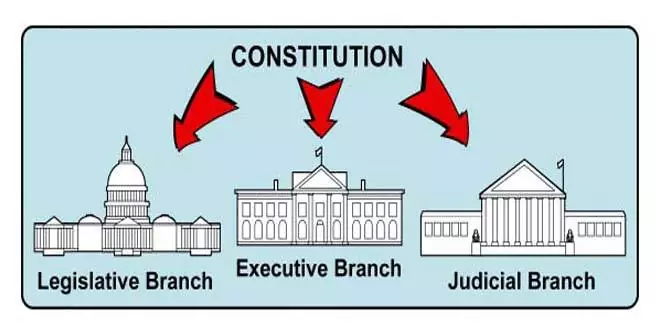In this Article we will discuss about the Doctrine of Separation of Powers and its relevance in Contemporary Times. So Let’s start-
Historical development of the Doctrine
The idea of the separation of powers finds its origins in ancient times, notably attributed to Aristotle, the Greek philosopher. However, it gained structured recognition through influential figures such as French philosopher John Bodin and British politician Locke during the 16th and 17th centuries. Yet, it was Montesquieu who, in his book ‘Esprit des Lois’ in 1748, provided the doctrine with a systematic and empirical formulation.
This model serves as a governance framework for democratic states, dividing the State into branches—
- executive,
- legislature, and
- judiciary
with distinct powers and responsibilities. The intent is to prevent any branch from overpowering the others. This model, while rooted in ancient Greece, found considerable use in the Roman Republic’s uncodified Constitution.
Separation of Powers in the Indian Context
Post-independence, India’s Constituent Assembly formed the country’s own Constitution. The Indian Constitution draws inspiration from various global constitutions but doesn’t contain a rigid, absolute division of the three government organs’ functions.
Executive powers are vested in the President (Articles 53(1) and 154(1)) for the Union and Governors for the States. The President acts as the Chief Executive Officer, exercising powers based on aid and advice from the Council of Ministers (Article 74(1)).
India’s Constitution doesn’t grant unlimited legislative powers to Parliament, State legislatures, or the judiciary. Article 50 emphasizes the separation of the judiciary from the executive to ensure functional parliamentary governance and the rule of law.
The President holds judicial responsibilities and decides disputed matters, especially regarding the retirement age of judges. However, in these judicial functions of significance, the President must consult only the Chief Justice and cannot act solely on ministerial advice (Article 60).
Regarding the Council of Ministers, joint responsibility to the People’s House and collective accountability contradicts the doctrine’s strict separation of powers. This collective responsibility creates intergovernmental accountability under the control of the legislative body.
Development on Separation of Powers and Cases
Ram Krishna Dalmia v. Justice Tendolkar: Justice Das highlighted that while India’s Constitution implicitly divides governmental powers among the legislative, executive, and judicial branches, the separation of powers isn’t a foundational cornerstone explicitly expressed in the Constitution.
Recognition of Independent Judiciary:
- Chandra Mohan v. State of U.P: Even though India doesn’t adopt a strict doctrine of separation of powers, it establishes an independent judiciary within the state, emphasizing the role of High Courts and their jurisdiction, including the power to issue writs against any governmental body.
Courts’ Stance on Doctrine:
- Udai Ram Sharma v. Union of India: The court explicitly stated that the American doctrine of separation of powers doesn’t apply to India’s constitutional setup.
Interpretation and Rulings:
- Ram Jawaya v State of Punjab: The court acknowledged that India’s Constitution doesn’t rigidly recognize the doctrine of separation of powers but ensures differentiation between governmental branches, preventing one branch from assuming the functions inherently belonging to another.
- I.G. Golak Nath v State of Punjab: Chief Justice Subha Rao emphasized that the Indian Constitution establishes distinct entities – the Union, States, and Union Territories – and delineates the functions of the Legislature, Executive, and Judiciary minutely, expecting each branch to operate within its designated sphere without overstepping.
Shifting Perspectives:
- Keshvananda Bharti v Union of India: The Supreme Court ruled that the amending powers are subject to the basic features of the Constitution, safeguarding these essential elements from unconstitutional amendments.
- Indira Gandhi Nehru v. Raj Narain: The court asserted that adjudication of specific disputes is a judicial function that Parliament, even with constitutional amending powers, cannot undertake. Allowing such overlap between the three organs of the state would lead to chaos.
What is Doctrine of Separation of Powers?
Separation of powers is the division of the legislative, executive, and judicial functions of government. Article 50 says that states shall take steps to separate the Judiciary from the Executive.
The constitutional demarcation precludes the concentration of excessive power by any branch of the government.
The Indian Constitution lays down the structure and defines and determines the role and functions of every organ of the State and establishes norms for their inter-relationships and checks and balances.
What is Separation of Powers in the Indian Context?
Post-independence, India’s Constituent Assembly formed the country’s own Constitution. The Indian Constitution draws inspiration from various global constitutions but doesn’t contain a rigid, absolute division of the three government organs’ functions.
References
- Vanderbilt, The Doctrine of separation of powers and its Present Day Significance, 38-45 (1953).
- http://www.raijmr.com/ijrhs/wp-content/uploads/2017/11/IJRHS_2014_vol02_issue_04_07.pdf
- The Constitution of India, Article 75(2).
- M.C.J. Kagzi, The Indian Administrative Law, p. 20



